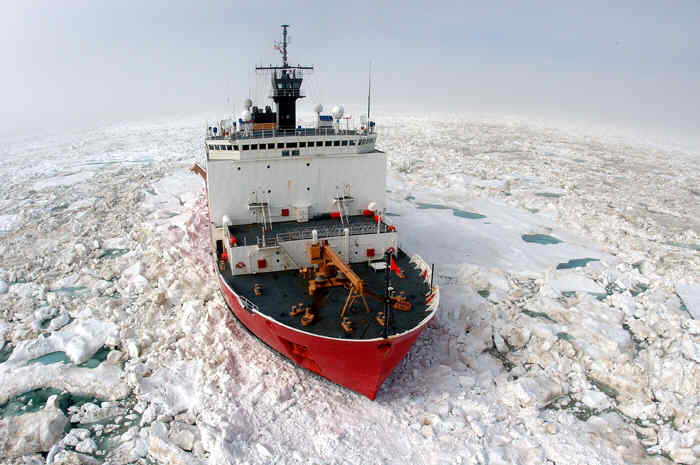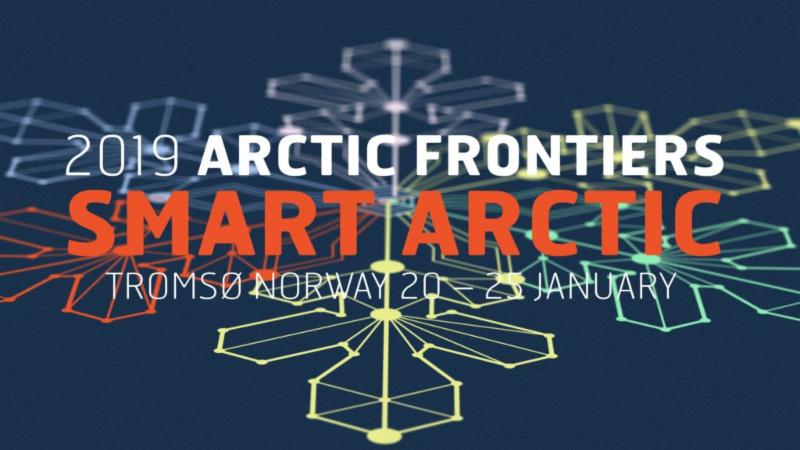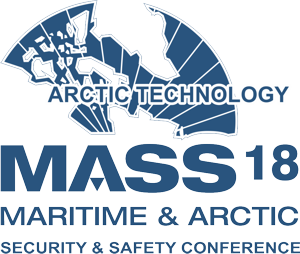|
|
|
|
|
|
|
|
No Arctic-science events are scheduled today.
|
Media
Here's How This Ghostly Fogbow Formed Over the Arctic Ocean. Do rainbows have ghosts? If you have ever seen a fogbow, then odds are your answer is "yes." Although it sounds crazy, fogbows are a real thing - and form in a similar fashion to rainbows. But unlike rainbows, these ghostly white fogbows are pale in comparison - quite literally! Ordinary rainbows occur when light enters a water droplet. Sunlight is a mix of all colors - but because they are all jumbled together, our eyes cannot pick out individual shades. The Washington Post
In Memoriam: Caitlyn Antrim. It is with profound sadness that the Stimson Center announces the death of one of our own, Caitlyn Antrim. Caitlyn passed away on July 28th, in Kingston, Jamaica where she was attending the 24th session of the International Seabed Authority Assembly. Caitlyn was a Nonresident Fellow of the Stimson Center and the Executive Director of the Rule of Law Committee on the Oceans, a group of scholars and practitioners in ocean law and diplomacy.
Previously, Caitlyn represented the US Department of Commerce at the Third UN Conference on the Law of the Sea in 1982, served as Repair Officer and Damage Control Assistant on the USS Schofield (FFG-3), and earned the professional degree of Engineer from the Department of Ocean Engineering at the Massachusetts Institute of Technology. Stimson Center
 An Ice-Free Oasis in the Arctic Sheltered Life During the Last Ice Age. An Ice-Free Oasis in the Arctic Sheltered Life During the Last Ice Age. The Arctic during the last ice age was essentially a desert. Land and ocean were both hidden under a thick sheet of ice. But scientists have long wondered if there were ice-free openings between land ice and sea ice, called polynyas, in which life could flourish. Now, researchers from the Geological Survey of Norway, and the UK, report evidence of these ice-free gaps from 20,000 years ago, during what is called the Last Glacial Maximum. ScienceNordic
How We Solved an Arctic Mercury Mystery. In the Canadian Arctic, a mystery has troubled scientists and local communities for decades: Why do marine animals in the western Arctic have higher mercury levels than those in the east? The trend is seen throughout the food web, from the tiny zooplankton that drift along ocean currents to large mammals like polar bears. It matters because mercury is a contaminant of global concern and communities in the North rely on the ocean for food. Mercury can cause reproductive problems in some animals, severe neurological damage in people and hamper the development of infants. Phys.org
Alaska Takes Center Stage at International Arctic Circle Assembly. Although Alaska is part of the United States, it is also among the few regions which inhabit the Arctic circle. To that end, Alaskan ambassadors are also world ambassadors when meeting with those other Arctic countries. At a symposium in Reykjavik, Iceland, Alaska senior Senator Lisa Murkowski spoke on the impact of Alaska to the Arctic region, as well as what she sees as the role of Alaskans in a broader sense as we fit in with the international community. KTUU
UTSA Creates Web-Based Open Source Dashboard of North Pole. It's called ArcCI (or Arctic CyberInfrastructure) and promises to combine the thousands of images that have been taken along the years of the Arctic Ocean into one global database that will help scientists and the world see the physical changes occurring in the region including ice loss. The hope is that this web-based repository will allow researchers to spend more time analyzing information rather than just collecting and processing data. "This is to help scientists spend more time doing the science," says Professor Alberto Mestas-Nuñez, one of two researchers at The University of Texas at San Antonio working on the on-demand data mining module. Phys.org
 Coast Guard Icebreaker Crew Completes Second Arctic Mission. Coast Guard Icebreaker Crew Completes Second Arctic Mission. The crew of the U.S. Coast Guard Cutter Healy completed their second mission of their Arctic West Summer 2018 deployment Thursday. Mission 1802 was a scientific mission to study stratified ocean dynamics in the Arctic (SODA) for the Office of Naval Research. The project, led by Dr. Craig Lee of the Applied Physics Laboratory at the University of Washington, Seattle, aims to better understand how the Arctic environment affects the different water layers of the Arctic Ocean. Understanding these environmental factors may help better predict ice coverage in the region. Alaska Native News
|
|
Future Events
Towards a Roadmap for Coordinated Arctic Observing, October 24, 2018 (Berlin, Germany). The side event is a follow up to the Arctic Observing Summit held in June 2018. The theme for the AOS was "Business Case for a Pan-Arctic Observing System." The first part of the session will demonstrate the value of Arctic observations, linking these to relevant Societal Benefit Areas. The second part will show how Arctic long-term observing systems are linked to and support decision-making from local to global scales. In the summing up panel, calls to action to the Arctic Science Ministerial will be formulated. This event is convened by the Sustaining Arctic Observing Networks (SAON) initiative of the Arctic Council, the European Commission, and the Arctic Observing Summit (AOS), an activity jointly overseen by SAON and the International Arctic Science Committee (IASC).
Arctic Science Forum Associated with the 2nd Arctic Science Ministerial, October 25, 2018 (Berlin, Germany and via webcast). How vulnerable and how resilient are nature and the people of the Arctic region? How well do we understand the regional and global dynamics which are driving change in the Arctic? What impact will change in the Arctic have on us? These and other questions are the focus of this two-day conference. It will take interdisciplinary research in the Arctic to gain an understanding of past and future processes - a complex and cost-intensive venture. This makes an international network of Arctic research so important for delivering better results. Cooperation in research, the exchange of data, collaborative observation and monitoring schemes - international cooperation is imperative in research on the Arctic.
Only the Science Forum, on October 25th, will be webcast. The Arctic Ministerial, on October 26th, will NOT be webcast.
aim of this Government of Canada and the Government of Newfoundland and Labrador supported international conference is to promote stakeholder collaboration, technological innovation, harsh environment research & development, and world-class education efforts that are contributing to both Maritime and Arctic issues. This two day conference will draw a diverse group of speakers and attendees representing government, military, Canadian and U.S. Coast Guard, industry, academic leaders, Northern Leaders, research and other key stakeholders. We hope you can join us to be a part of this important dialogue
American Geophysical Union Fall meeting, December 10-14, 2018 (Washington, DC USA). The AGU 2018 Fall Meeting will mark another dynamic year of discovery in Earth and space science, serve as the advent of AGU's Centennial year, and provide a special opportunity to share our science with world  leaders in Washington, D.C. As the largest Earth and space science gathering in the world, the Fall Meeting places you in the center of a global community of scientists drawn from myriad fields of study whose work protects the health and welfare of people worldwide, spurs innovation, and informs decisions that are critical to the sustainability of the Earth.
ArcticNet: Annual Scientific Meeting 2018, December 10-14, 2018 (Ottawa, ON Canada). Canada's North is experiencing unprecedented change in its sea and terrestrial ice, permafrost and ecosystems under the triple pressures of climate change, industrialization and modernization. The impacts of these pressures can be seen on food and energy security, shipping, sovereignty, northern community health and well-being, and sustainable development and resource exploitation. All these issues have brought the North to the forefront of national and international agendas. Building on the success of its previous Annual Scientific Meetings and International Arctic Change Conferences, the Arctic Network of Centers of Excellence announces the 14th ArcticNet Annual Scientific Meeting.
 Arctic Frontiers, January 20-25, 2019 (Tromso, Norway). The Arctic Frontiers is a global scientific conference on economic, societal, and environmental sustainable growth. This year's theme will be "Smart Arctic," with a pan-arctic emphasis, and an effort to build new partnerships across nations, generations and ethnic groups. Arctic Frontiers provides a forum for dialogue and communication between science, government and industry. The plenary program will have five main sessions: State of the Arctic, Blue Growth, Smart Solutions, Bridging the Gap, and Arctic business prospects. An abstract-driven science program will address Plastics in the Ocean, the Future of Governance and Handling Vulnerability in Arctic Ecosystems, State of the Arctic and A Smart Arctic Future.
 of the AAG includes over 8,500 geographers converging from the U.S., Canada, and nearly 60 other countries in a typical year including geographers, GIS specialists, environmental scientists, and other leaders for the latest in research and applications in geography, sustainability, and GIScience. of the AAG includes over 8,500 geographers converging from the U.S., Canada, and nearly 60 other countries in a typical year including geographers, GIS specialists, environmental scientists, and other leaders for the latest in research and applications in geography, sustainability, and GIScience.
|
|

  
4350 N. Fairfax Drive, Suite 510
Arlington, VA 22203, USA
External links in this publication, and on the USARC's World Wide Web site ( www.arctic.gov) do not constitute endorsement by the US Arctic Research Commission of external Web sites or the information, products or services contained therein. For other than authorized activities, the USARC does not exercise any editorial control over the information you may find at these locations. These links are provided consistent with the stated purpose of this newsletter and the USARC Web site.
|
|
|
|
|
|
|
|
|
 An Ice-Free Oasis in the Arctic Sheltered Life During the Last Ice Age. The Arctic during the last ice age was essentially a desert. Land and ocean were both hidden under a thick sheet of ice. But scientists have long wondered if there were ice-free openings between land ice and sea ice, called polynyas, in which life could flourish. Now, researchers from the Geological Survey of Norway, and the UK, report evidence of these ice-free gaps from 20,000 years ago, during what is called the Last Glacial Maximum. ScienceNordic
An Ice-Free Oasis in the Arctic Sheltered Life During the Last Ice Age. The Arctic during the last ice age was essentially a desert. Land and ocean were both hidden under a thick sheet of ice. But scientists have long wondered if there were ice-free openings between land ice and sea ice, called polynyas, in which life could flourish. Now, researchers from the Geological Survey of Norway, and the UK, report evidence of these ice-free gaps from 20,000 years ago, during what is called the Last Glacial Maximum. ScienceNordic Coast Guard Icebreaker Crew Completes Second Arctic Mission. The crew of the U.S. Coast Guard Cutter Healy completed their second mission of their Arctic West Summer 2018 deployment Thursday. Mission 1802 was a scientific mission to study stratified ocean dynamics in the Arctic (SODA) for the Office of Naval Research. The project, led by Dr. Craig Lee of the Applied Physics Laboratory at the University of Washington, Seattle, aims to better understand how the Arctic environment affects the different water layers of the Arctic Ocean. Understanding these environmental factors may help better predict ice coverage in the region. Alaska Native News
Coast Guard Icebreaker Crew Completes Second Arctic Mission. The crew of the U.S. Coast Guard Cutter Healy completed their second mission of their Arctic West Summer 2018 deployment Thursday. Mission 1802 was a scientific mission to study stratified ocean dynamics in the Arctic (SODA) for the Office of Naval Research. The project, led by Dr. Craig Lee of the Applied Physics Laboratory at the University of Washington, Seattle, aims to better understand how the Arctic environment affects the different water layers of the Arctic Ocean. Understanding these environmental factors may help better predict ice coverage in the region. Alaska Native News
 must-attend event to gain a wide perspective on challenges, opportunities and policies related to the Arctic and North Atlantic maritime environments. The
must-attend event to gain a wide perspective on challenges, opportunities and policies related to the Arctic and North Atlantic maritime environments. The 
